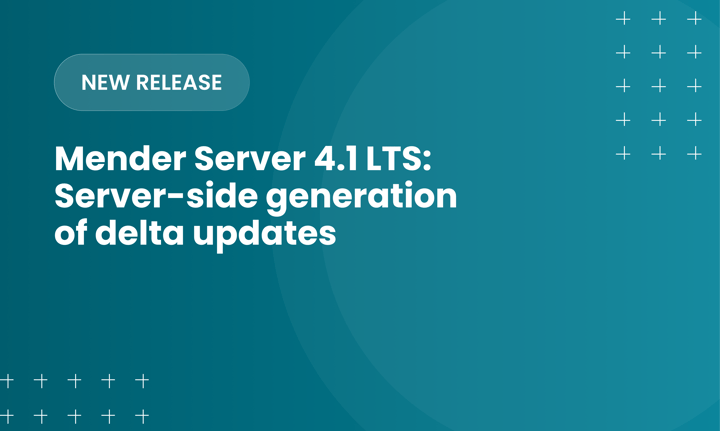There’s no getting around it—we live in a connected world where almost every industry is dependent on the Internet of Things (IoT).
According to Statista, the use of IoT devices worldwide will increase from 17 billion in 2024 to almost 30 billion in 2030. IoT and smart, embedded technology have enabled many industries — that initially found it difficult to adapt to remote functionality — to automate processes and reduce organizational risk. The increase in IoT devices translates to use cases in all types of industry verticals and consumer markets, from emergency services and communication to transportation and medical to smart energy and manufacturing.
For IoT devices and applications to progress, they must continually evolve. The evolving nature of the technology behind IoT devices necessitates a mechanism to update devices once in production – in the field, wherever they may exist. And do so securely and robustly, or risk rendering the device inoperable.
IoT devices and over-the-air (OTA) software updates go hand-in-hand. OTA software updates are vital to keeping essential systems maintained, current, scalable, and secure. In sectors like emergency services, for example, OTA updates become mission-critical, ensuring their respective IoT devices function at the top of their game in situations where seconds make all the difference.
Watch Duty: Protecting emergency fire intel
Where are OTA updates mission-critical? Emergency fire response. In this scenario, real-time situational awareness could mean the difference between life and death, and IoT devices provide a way to help ensure safety.
Watch Duty, a nonprofit organization, alerts individuals of nearby wildfires and firefighting efforts in real-time. It is a monitoring application designed to gather real-time intel about wildfires from cameras, satellites, law enforcement, and other fire services. Watch Duty’s IoT device, Echo, allows expanded capabilities to enhance communication between first responders and emergency services. It enables remote listening and, most importantly, alleviates radio dead zones in more secluded areas.
A significant issue with dozens of devices already in the field, Watch Duty’s homegrown remote management solution suffered from severe scalability, security, and robustness issues, including the risk of VPN compromises. Additionally, it required a lot of time to maintain, and only its creator knew how to properly use the solution, resulting in wasted time and a single point of failure. In scenarios where response time is seconds and radio frequencies change during a wildfire, Echo devices require a scalable and robust update mechanism.
How Mender helped streamline operations
Watch Duty replaced its homegrown infrastructure with Mender, leveraging a scalable and secure OTA update infrastructure. Now, the team can seamlessly upgrade and maintain their Echo radios without physical access.
“Our deployment process was initially limited, relying on a VPN mesh and custom scripts. Switching to Mender has streamlined our operations, enabling standardized setups with OS images, one-click GitHub PR deployments, and enhanced security through unique user accounts.”
Nick Russell, VP of Operations
Managing OTA updates through a purpose-built solution safeguards operations while enhancing the security, reliability, and interoperability across its fleet of connected IoT devices. With Mender, Watch Duty now spends less time on infrastructure and more time on its products, giving them peace of mind using a robust and proven OTA solution.
Today, OTA software update functionality is the most effective strategy for deploying remote updates to smart devices and significantly improving process efficiency.
Why are OTA updates important?
Failure to keep devices properly updated can result in security and data breaches, deteriorated user experience (UX), and compatibility issues. In worst-case scenarios, the failure to update devices properly can render them inoperable. OTA updates are not only efficient for organizations (versus onsite or physical connection updates) but enable risk mitigation, among other benefits, including faster time-to-market, greater agility, and supporting continuous integration and continuous delivery or deployment (CI/CD) software development lifecycle strategies:
- Improve performance: Optimizations and bug fixes made possible by OTA update infrastructure help keep systems running smoothly, ensure stability, and improve overall device quality, resulting in superior user experiences and customer value.
- Enhance functionality and new features: Leveraging OTA updates enables OEMs to release the latest features and improvements faster, efficiently, and at scale. In turn, users realize greater value from their IoT products and enhance overall value.
- Ensure security and compliance: Current and upcoming cybersecurity regulations mandate the ability to identify and mitigate known security threats. The OTA update infrastructure is critical to deploying security patches to the right device-software mix at the right time. Cyber adversaries and hackers often target outdated devices, so keeping them up-to-date is a crucial defense against cyberattacks and breaches.
Why leverage a best-in-class OTA update infrastructure?
Leveraging a professional OTA update infrastructure alleviates the need for OEMs to invest considerable time, resources, and effort into building bespoke proprietary software update systems. Third-party OTA update solutions come equipped for rapid integration and robustness, supporting pre-tested protocol libraries and embedded security and compliance with functional safety, cybersecurity, and data privacy standards or regulations.
Some of the world’s largest enterprises in diverse industries use OTA update providers to facilitate remote software management for their device fleets worldwide. From smart elevators to maritime connectivity and healthcare to smart coffee machines, a best-in-class OTA update offers numerous benefits, including 24/7 monitoring, live troubleshooting, configuration management, or operational efficiency, like network cost and bandwidth management.
Recent articles
The differences between the US FDA’s device approval process and the EU’s medical device regulation (MDR): An essential dual-compliance framework for global manufacturers
Why OTA updates are now mission critical for future-proofed device lifecycle management
What’s new in Mender: Server-side generation of delta updates
Learn why leading companies choose Mender
Discover how Mender empowers both you and your customers with secure and reliable over-the-air updates for IoT devices. Focus on your product, and benefit from specialized OTA expertise and best practices.





